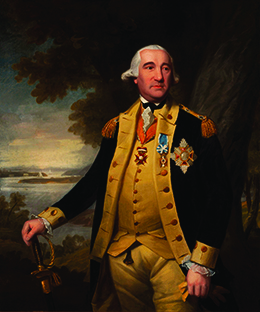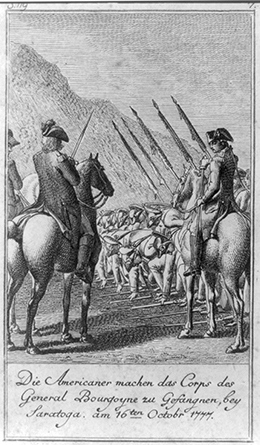| << Chapter < Page | Chapter >> Page > |
Visit Wikisource to read the rest of Thomas Paine’s first American Crisis pamphlet, as well as the other fifteen in the series.
In August 1777, General Howe brought fifteen thousand British troops to Chesapeake Bay as part of his plan to take Philadelphia, where the Continental Congress met. That fall, the British defeated Washington’s soldiers in the Battle of Brandywine Creek and took control of Philadelphia, forcing the Continental Congress to flee. During the winter of 1777–1778, the British occupied the city, and Washington’s army camped at Valley Forge, Pennsylvania.
Washington’s winter at Valley Forge was a low point for the American forces. A lack of supplies weakened the men, and disease took a heavy toll. Amid the cold, hunger, and sickness, soldiers deserted in droves. On February 16, Washington wrote to George Clinton, governor of New York: “For some days past, there has been little less than a famine in camp. A part of the army has been a week without any kind of flesh&the rest three or four days. Naked and starving as they are, we cannot enough admire the incomparable patience and fidelity of the soldiery, that they have not been ere [before] this excited by their sufferings to a general mutiny and dispersion.” Of eleven thousand soldiers encamped at Valley Forge, twenty-five hundred died of starvation, malnutrition, and disease. As Washington feared, nearly one hundred soldiers deserted every week. (Desertions continued, and by 1780, Washington was executing recaptured deserters every Saturday.) The low morale extended all the way to Congress, where some wanted to replace Washington with a more seasoned leader.
Assistance came to Washington and his soldiers in February 1778 in the form of the Prussian soldier Friedrich Wilhelm von Steuben ( [link] ). Baron von Steuben was an experienced military man, and he implemented a thorough training course for Washington’s ragtag troops. By drilling a small corps of soldiers and then having them train others, he finally transformed the Continental Army into a force capable of standing up to the professional British and Hessian soldiers. His drill manual— Regulations for the Order and Discipline of the Troops of the United States —informed military practices in the United States for the next several decades.

Explore Friedrich Wilhelm von Steuben’s Revolutionary War Drill Manual to understand how von Steuben was able to transform the Continental Army into a professional fighting force. Note the tremendous amount of precision and detail in von Steuben’s descriptions.
Meanwhile, the campaign to sever New England from the rest of the colonies had taken an unexpected turn during the fall of 1777. The British had attempted to implement the plan, drawn up by Lord George Germain and Prime Minister Lord North, to isolate New England with the combined forces of three armies. One army, led by General John Burgoyne, would march south from Montreal. A second force, led by Colonel Barry St. Leger and made up of British troops and Iroquois, would march east from Fort Oswego on the banks of Lake Ontario. A third force, led by General Sir Henry Clinton, would march north from New York City. The armies would converge at Albany and effectively cut the rebellion in two by isolating New England. This northern campaign fell victim to competing strategies, however, as General Howe had meanwhile decided to take Philadelphia. His decision to capture that city siphoned off troops that would have been vital to the overall success of the campaign in 1777.
The British plan to isolate New England ended in disaster. St. Leger’s efforts to bring his force of British regulars, Loyalist fighters, and Iroquois allies east to link up with General Burgoyne failed, and he retreated to Quebec. Burgoyne’s forces encountered ever-stiffer resistance as he made his way south from Montreal, down Lake Champlain and the upper Hudson River corridor. Although they did capture Fort Ticonderoga when American forces retreated, Burgoyne’s army found themselves surrounded by a sea of colonial militias in Saratoga, New York. In the meantime, the small British force under Clinton that left New York City to aid Burgoyne advanced slowly up the Hudson River, failing to provide the much-needed support for the troops at Saratoga. On October 17, 1777, Burgoyne surrendered his five thousand soldiers to the Continental Army ( [link] ).

The American victory at the Battle of Saratoga was the major turning point in the war. This victory convinced the French to recognize American independence and form a military alliance with the new nation, which changed the course of the war by opening the door to badly needed military support from France. Still smarting from their defeat by Britain in the Seven Years’ War, the French supplied the United States with gunpowder and money, as well as soldiers and naval forces that proved decisive in the defeat of Great Britain. The French also contributed military leaders, including the Marquis de Lafayette, who arrived in America in 1777 as a volunteer and served as Washington’s aide-de-camp.
The war quickly became more difficult for the British, who had to fight the rebels in North America as well as the French in the Caribbean. Following France’s lead, Spain joined the war against Great Britain in 1779, though it did not recognize American independence until 1783. The Dutch Republic also began to support the American revolutionaries and signed a treaty of commerce with the United States in 1782.
Great Britain’s effort to isolate New England in 1777 failed. In June 1778, the occupying British force in Philadelphia evacuated and returned to New York City in order to better defend that city, and the British then turned their attention to the southern colonies.
The British successfully implemented the first part of their strategy to isolate New England when they took New York City in the fall of 1776. For the next seven years, they used New York as a base of operations, expanding their control to Philadelphia in the winter of 1777. After suffering through a terrible winter in 1777–1778 in Valley Forge, Pennsylvania, American forces were revived with help from Baron von Steuben, a Prussian military officer who helped transform the Continental Army into a professional fighting force. The effort to cut off New England from the rest of the colonies failed with the General Burgoyne’s surrender at Saratoga in October 1777. After Saratoga, the struggle for independence gained a powerful ally when France agreed to recognize the United States as a new nation and began to send much-needed military support. The entrance of France—Britain’s archrival in the contest of global empire—into the American fight helped to turn the tide of the war in favor of the revolutionaries.

Notification Switch
Would you like to follow the 'U.s. history' conversation and receive update notifications?